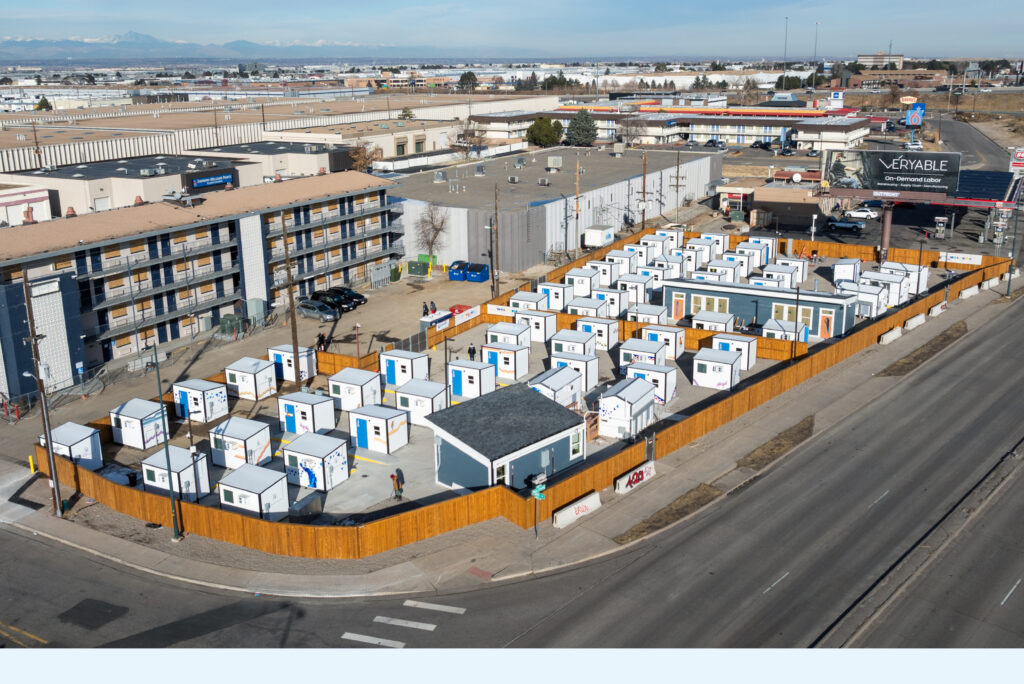Why Pallet is Driven by Trauma-Informed Design
January 30, 2024
Adopting the principles of trauma-informed design is a crucial framework for creating a safe, supportive, and healing environment in every shelter we build.

When developing and designing Pallet shelters, our top priority is to best serve the needs of displaced populations. This is why we have our dignity standards in place: to ensure that each shelter village provides a positive, supportive community environment for every resident.
But we also understand our responsibility to design our shelters so they offer a private, healing atmosphere for people to plan their transitions to more permanent solutions. It has long been understood that the way we interact with and utilize physical spaces—along with our emotional and psychological reactions to those spaces—are dictated by a wide range of design choices. An airy, open lobby with large windows and ample natural lighting is bound to elicit a completely different response compared to an enclosed, fluorescent-lit office.
Only recently has this concept been integrated into architectural design specifically catered to vulnerable users. With trauma-informed care as a framework, trauma-informed design (TID) seeks to create physical spaces centered around principles like safety, empowerment, and well-being. Building with these concepts in mind can actively aid a person’s development, grow their ability to trust others, and avoid the possibility of re-traumatization.
Experiencing chronic homelessness, coping with substance use disorder, reintegrating into the community after being incarcerated, or suddenly losing your home to a natural disaster are all traumatic experiences. By viewing our product development and engineering processes through the lens of TID and incorporating features that promote healing, inclusion, and stabilization, we aim to provide shelter that supports the needs of those impacted by the trauma of displacement.
Here are some of the ways we applied the four main principles of TID—Safety & Trust; Choice & Empowerment; Community & Collaboration; and Beauty & Joy—in the design of our innovative S2 shelter line:
- Privacy: A key aspect of TID is privacy. When someone moves into a Pallet shelter, they are able to access a personal space of their own with a locking door. For people who have experienced living unsheltered, staying in congregate settings, or being incarcerated, walking through the door with to a private and restful place is a powerful moment.
- Security: In addition to a locking solid core door equipped with a kick plate and peephole, having each shelter as part of a larger community model with onsite security personnel makes residents feel less isolated, even when enjoying the privacy of their own unit. Outside lighting also promotes a feeling of safety for residents of Pallet villages.
- Safety Features: Extensive product testing guarantees that S2 shelters are safe in even extreme conditions—whether it’s wind, snow, rain, or extreme cold. Each unit is equipped with a smoke/CO detector, a fire extinguisher, and an egress window in case of emergency.
- Residential Fixtures: Interior options like a freestanding bed and desk visually separate S2 shelters from institutional settings while allowing for a customizable layout. Features like operable residential windows and LED lighting also help residents minimize associations with environments where they potentially experienced trauma. The S2 EnSuite, Pallet’s first sleeping shelter with an integrated bathroom, includes a toilet, sink, and shower. For vulnerable populations with specific traumatic experiences, access to private hygiene facilities can be a significant step toward healing.
- Climate Control Options: Beyond keeping shelters warm in the winters and cool in the summers, integrated heating and A/C allows residents to freely adjust temperatures to fit their personal preferences.
- Storage and Organization: Integrated shelving and storage space grant residents to safely store their possessions, display meaningful belongings, and organize necessities like clothes and food—bringing a sense of autonomy and respect not found in institutional settings.
- Clean, Simple Aesthetic: Pallet’s patent pending connection system and the structurally insulated panels used in the S2 line allow for smooth exterior and interior walls, creating a warm, inviting environment in each shelter.
Pallet is committed to applying the philosophy of TID in our shelters to accommodate village residents who have lived through trauma. Applying these concepts, along with listening to feedback from real users and our own lived experience workforce, helped us develop the S2 shelter line as our most innovative solution to the crisis of human displacement. We believe that every design detail, no matter how small it may seem, can make a big difference in someone’s journey to permanent housing and reintegration.
To see how S2 shelters provided rapid shelter and warmth for unhoused Denver residents by the New Year, read our case study.


